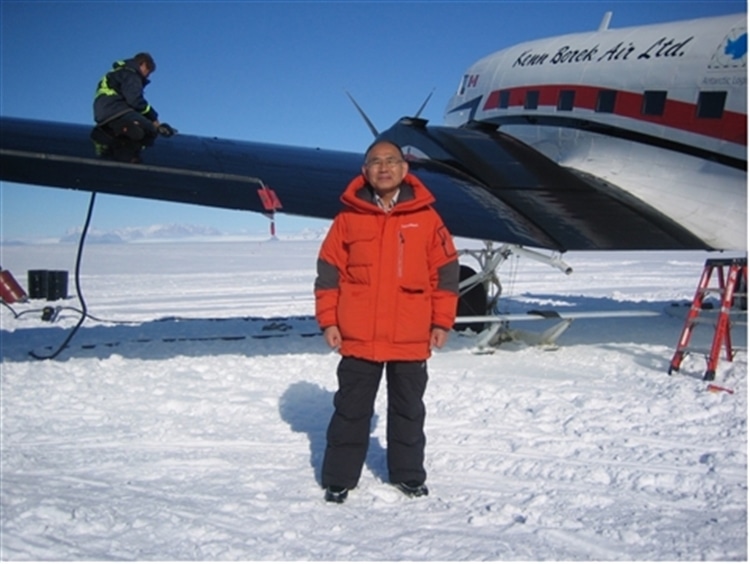- TOP
- Research
- Research Features List
- In the Lab
- Discovering the Romance of Space: The Challenge of Proving the Existence of Black Holes

Space: wrapped in a veil of mystery, it sparks our curiosity like nothing else. In the “Discovering the Romance of Space” series, we asked researchers involved in the space field to talk about their research and the romance of space. For the first installment, we spoke to Professor NAKAI Naomasa, who was the first to prove the existence of black holes. What are black holes in the first place, how is their existence observed, and what mysteries will be unraveled? We drew closer to the romance of space. NAKAI Naomasa Doctor of Science. Took up his current post after serving as a Professor at the National Astronomical Observatory of Japan and the Director of the Nobeyama Radio Observatory, among other positions. Is conducting research to elucidate on the mysteries of the structure, formation, and evolution of galaxies, galactic systems, black holes, and other celestial objects through radio astronomy observations. Currently devoting himself to a project to build a high-precision radio telescope on a plateau in the inland area of Antarctica, which is the best point on land for astronomical observations, and promoting Antarctic astronomy to observe galaxies that existed 13 billion years ago and investigate the birth and evolution of galaxies. Summary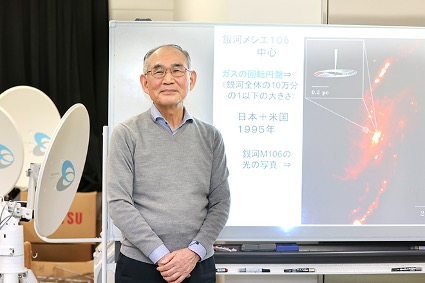
Professor, Kwansei Gakuin University School of Science
• A black hole is a celestial object from which no matter can escape, due to its immense gravity.
• The world's first confirmation of the existence of a black hole came from an accidental discovery.
• If a terahertz telescope (a high-precision radio telescope) is successfully built in Antarctica, it will be possible to observe the early universe.
Not even light can escape a black hole, let alone matter.
What is a black hole? As Prof. Nakai explains, “In a nutshell, a black hole is a celestial object with such immense gravity from which nothing - not even light, let alone matter - can escape.” Why can nothing escape from a black hole? Using the earth as an example, Prof. Nakai explains thusly:
“For example, the faster you throw a ball, the farther you can throw it. If you could send a ball flying farther than the radius of the earth, it would go around the planet and come back. Then, according to calculations, a ball thrown at 11 km/s or more would be able to escape from the earth’s gravity (Fig. 1). However, if we were to temporarily make the earth’s mass over 2,200 times greater than that of the sun, or compress its radius down to under two centimeters, its gravity would be so strong that even something moving at the speed of light would be unable to escape (Fig. 2). The earth would become a black hole.”

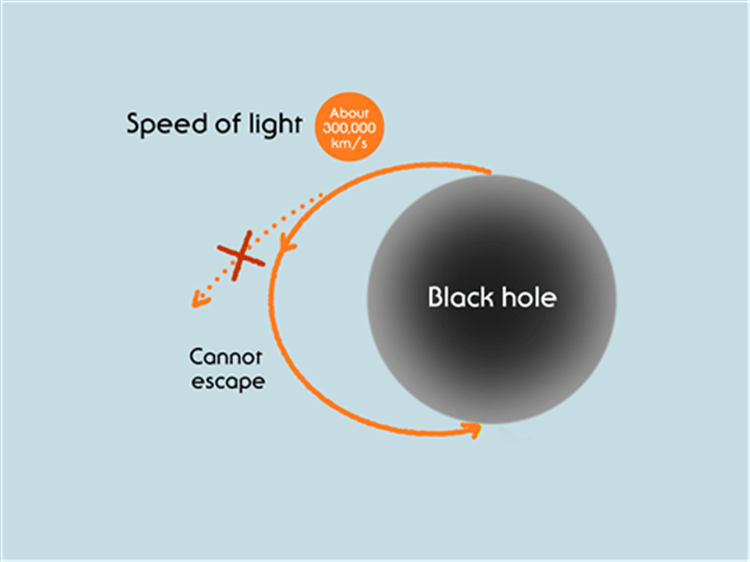
The existence of black holes was first predicted in 1784. Using Isaac Newton’s law of universal gravitation, an English researcher published a paper saying that it was possible to imagine a celestial object in space that even something traveling at the speed of light could not escape. Prof. Nakai adds, “However, there was a problem with that explanation. Light has no mass, so it cannot be attracted by the gravity of the earth.” A modern theory of black holes was made public in 1916. In his general theory of relativity, Einstein proposed that strong gravitational force is caused by the presence of massive objects, and that space affected by this force is warped. In response to this idea, a German researcher showed that although light has the property of traveling straight through space, if the space is affected by too much gravitational force, the light will be greatly warped and ends up returning to its original state, becoming unable to escape. This is a black hole.”
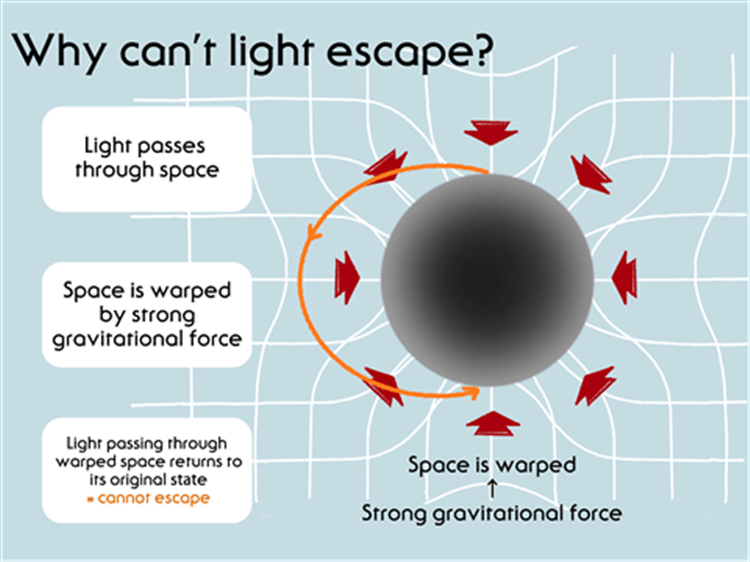
Since a black hole absorbs everything in its gravitational field, its existence cannot be observed. As Prof. Nakai explains, “In other words, to put it in strict terms, there is no real ‘discovery’ of a black hole. What we call ‘discovery’ is looking at outside movement to prove there is a high likelihood of a black hole existing somewhere. That is because if there is a black hole in the galaxy, we can observe light vand radio waves from the stars and gases which surround it, since the objects outside its gravitational radius can exist without being absorbed.” British astrophysicist Donald Lynden-Bell published a theory in 1969 that galaxies have massive black holes at their centers. In the years that followed, although there were many reports of black hole discoveries, none of them could be proved. They could even be explained away as star clusters. Amidst those circumstances, Prof. Nakai was the primary investigator for one of the first research groups in the world to discover a celestial object which could not be explained without being a black hole. Looking back, he says that it was a serendipitous discovery.

The man who foresaw black holes told us, “I have waited for this day to come for 26 years.”
A water maser was the probe for Prof. Nakai proving the existence of black holes. A maser arises from the same principle as a laser and emits microwaves, which are radio waves, instead of light. A maser that does so from water molecules is called a water maser. Everything began in 1984, when a German radio telescope discovered an extremely powerful water maser coming from the center of the Messier 106 (M106) Galxy. “There are also water masers coming from various areas in the Milky Way, where we live. However, the radio waves emitted by the water maser discovered in M106 were several million times more powerful than those emitted by water masers in the Milky Way. After that, the object was observed dozens of times with Western radio telescopes, but its origin was unknown. In 1991, an American group received attention for announcing that they had discovered that the strength of these radio waves would increase or decrease every 85 days. I was curious why they would make periodic variations.”
By around 1990, it was confirmed that strong water masers, called megamasers, were being emitted from five galaxies. At the Nobeyama Radio Observatory in Nagano Prefecture, where Prof. Nakai was conducting research at the time, he says that he then observed the galaxies other than M106 to see if they were also changing periodically. Three out of the five galaxies, including M106, could be observed from Japan. “To investigate this, I needed a radio spectrometer that can measure the intensity of each maser feature. At the time, radio telescopes overseas were equipped with one or two radio spectrometers. The 45m radio telescope at Nobeyama was the only one in the world to be equipped with eight radio spectrometers. I thought that I might as well use all of them to observe the three galaxies, and when I did, I found a water maser in M106 with an extremely-high-velocity emission of 3.6 million km/h.”
No such emission had ever been confirmed in about 70 years since the galaxy had been discovered. “I thought, if this is real, this is an incredible discovery. I could feel my head getting hot. But maybe there was an error, and the emission wasn’t actually this fast. If I went around boasting to everyone that I’d made an amazing discovery, and it turned out to be a mistake, I’d be pretty embarrassed,” Prof. Nakai said with a laugh. “I didn’t announce anything for a month, and checked over and over to determine whether or not it was real.”
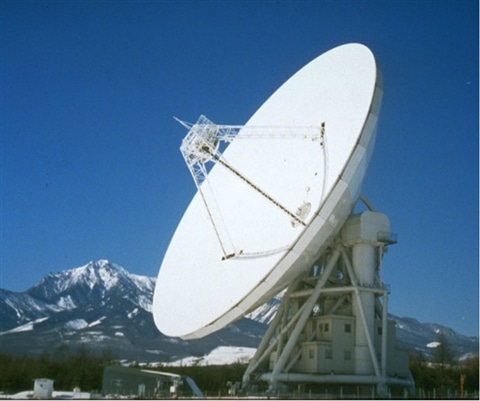
After using every possible means to investigate what had been observed, Prof. Nakai was confident that there was a water maser coming from the center of the galaxy. His paper on that information was published in the international science journal Nature in 1993. One of the paper’s reviewers wrote, “Astronomers around the world who saw this article will probably dash to their telescopes.” Naturally, I also wanted to know the object’s true nature. Around that time, the Americans had just completed the Very Long Baseline Array (VLBA) with 10 antennas with a diameter of 25m, located in the United States, so my group called for a joint research project and asked them to respond. As a result, we found out that there is a gas disk rotating at a speed of 3.6 million km/h around the center of the M106 galaxy.”

Through our observations, we learned that the movement of the gas disk is a Kepler rotation that becomes faster as it gets closer to the center, like the planets of the solar system. If we make calculations using that distance and speed, then there is an object in the center of the galaxy with a mass 39 million times that of the sun. This object cannot be explained away as a star cluster or gas. The only explanation is that there is a black hole at the center of M106. Having obtained the first clear evidence of a supermassive black hole, the results of Prof. Nakai’s group were once again published in Nature in 1995. “Dr. Lynden-Bell, who saw our article, was so overjoyed that he sent us a letter saying, ‘I have waited for this day to come for 26 years.’
This discovery proved the existence of black holes with a million times greater certainty than previous discoveries, but about two years later, Reinhard Genzel and his colleagues in Germany discovered a black hole in the Milky Way Galaxy, where the Earth is located, with the same degree of certainty as ours. They continued their observations and proved the existence of the black hole with a thousand times greater certainty, and in 2020, he and Andrea Ghez won the Nobel Prize for Physics. Although we were the first to discover a black hole, it seems that their more solid evidence was the reason that they were selected to receive the Nobel Prize."
Unraveling the mysteries of the universe from Antarctica, the best point on land for astronomical observation.
Professor Nakai went on to discover black holes in other galaxies, as well. However, when and how black holes were formed is still a mystery. "We know that around 700 million years after the universe was born by the Big Bang, there were already black holes that were billions of times larger than the sun. However, this conflicts with our current research, as it should take several billion years for such supermassive black holes to be formed. In order to clarify the mysteries regarding the formation of these sorts of supermassive black holes that exist in the centers of galaxies, we must observe galaxies and black holes in the very distant early universe.”
For example, light emitted from celestial objects that are 100,000 light-years away will continue to fly through space and arrive at the earth 100,000 years later. In other words, the form of the celestial objects that we can see from the earth is what they looked like 100,000 years ago. Similarly, if we can observe light in space that was emitted 10 billion years ago, it is possible for us to know the initial appearance of the universe. Prof. Nakai is working on preparations for these extraordinary observations.
“Only 10% to 20% of galaxies that are extremely far away have been observed with visible light. However, it is possible to observe the remaining galaxies with high frequency radio waves. For example, by using a telescope that can observe terahertz waves (radio waves that are close to infra-red light), galaxies over 13 billion light-years away can be seen brightly.” However, such high frequency radio waves are absorbed by water vapor in the atmosphere, and it is difficult for them to reach the ground. That is why Prof. Nakai has been working since 2004 on a plan to construct an astronomical observatory on the Antarctic continent.
“Mountainous areas where the air is thin, as well as deserts, are suitable for observation. The inland area of the Antarctic continent is the biggest desert on earth, as well as the place with the least water vapor. The area is also at a high altitude of 3,800 to 4,000 meters. Furthermore, for 70% of the year, there are clear skies, and the weather is sunny 90% of the time. My current goal is to construct a 12m high-precision radio telescope in this area, capable of simultaneously observing four areas in the sky a month. Once completed, we will be able to make observations in one year that would have taken over 100 years with existing telescopes."
The proposed site is about 1,000 km inland from Showa Station, a Japanese research station in Antarctica. Prof. Nakai is moving forward with setting up the observatory in the area of the new Dome Fuji Station, which the National Institute of Polar Research is working to build.
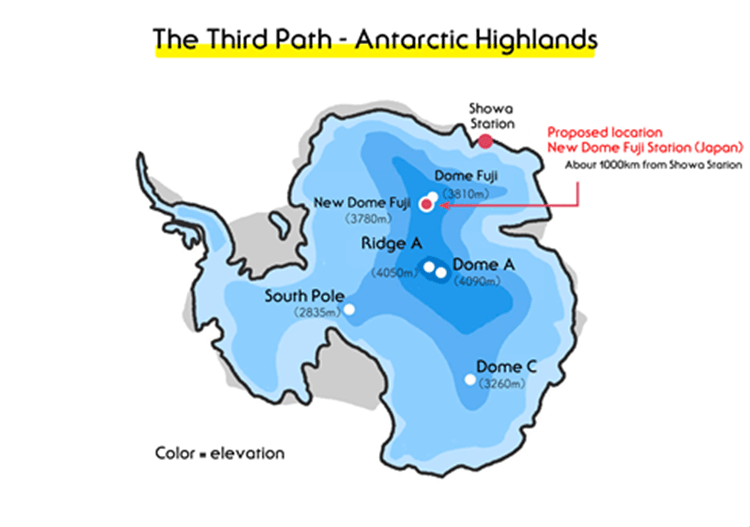
“Although there was a plethora of technical issues, many of them have been addressed, and the only thing that is currently problematic is the financial aspect. I am soliciting donations, because it will cost over two billion yen to build the telescope. The project has already attracted attention from overseas astronomers, so I would like to complete it as an international Antarctic observatory led by Japan.” Professor Nakai developed an interest in space when his older sister, who was four years older than him, bought a small telescope for him as a fifth-grade student in elementary school. “How old is space, really? When were black holes formed? Trying to learn about things we still don’t understand is interesting. It’s really fantastic,” he says, his eyes lit up. From the smile on Prof. Nakai’s face, we could see that it is very rewarding to face the universe as a researcher.
